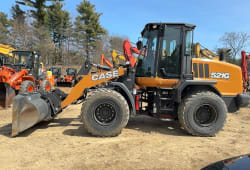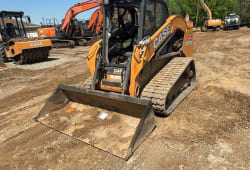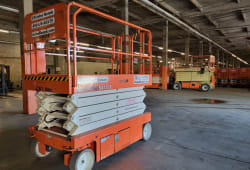Straight-Line Method: A Simple Approach to Heavy Equipment Depreciation
6 Min read
)
February 20, 2025
Depreciation is a key concept in accounting, particularly when managing assets. It helps businesses spread the cost of an asset over its useful life. Among various depreciation methods, the Straight-Line method stands out for its simplicity and consistency. This method is often used to calculate depreciation for long-term assets such as buildings, vehicles, and heavy equipment.
In this blog, we’ll explore the Straight-Line method, how it works, and why it’s a popular choice for businesses dealing with heavy equipment depreciation. Additionally, we will compare the Straight-Line method with the Double Declining Balance method to help you choose the best option for your asset management needs.
What is the Straight-Line Method?
The Straight-Line method is one of the most widely used ways to calculate depreciation. It involves spreading the cost of an asset evenly over its useful life, resulting in the same depreciation expense each year.
This method is favored by businesses because of its simplicity and predictability. It works well for assets that lose value at a steady rate over time, which is often the case for certain types of machinery, vehicles, and other long-term assets.
How the Straight-Line Method Works
The Straight-Line method formula is easy to apply. The formula is:
:format(webp)) Here’s how it works:
Here’s how it works:
Cost of Asset: This is the initial purchase price of the asset.
Salvage Value: This is the estimated residual value of the asset at the end of its useful life.
Useful Life: This is the number of years the asset is expected to be used.
Once the depreciation expense is calculated, it remains the same for each year of the asset’s life. This makes financial planning easier for businesses.
For example, if you purchase a piece of heavy equipment for $100,000 with a useful life of 10 years and a salvage value of $20,000, the annual depreciation would be:
100,000−20,00010=8,000\frac{100,000 - 20,000}{10} = 8,00010100,000−20,000=8,000
This means the equipment will depreciate by $8,000 every year for 10 years.
Straight-Line Method in Heavy Equipment Depreciation
:format(webp))
When it comes to heavy equipment depreciation, the Straight-Line method is particularly effective for assets that have a predictable, consistent usage pattern. Heavy equipment such as bulldozers, cranes, and trucks often have long useful lives and can experience relatively steady wear and tear.
The Straight-Line method in heavy equipment depreciation is ideal because:
It simplifies the depreciation calculation, making it easier to budget for the equipment’s costs over time.
It aligns well with equipment that does not experience rapid obsolescence or heavy usage in the early years.
For example, if a construction company purchases an excavator for $150,000, with a useful life of 15 years and a salvage value of $30,000, the company can expect a consistent depreciation expense of $8,000 per year, making long-term financial planning more straightforward.
Advantages of Using the Straight-Line Method
There are several reasons why the Straight-Line method is popular among businesses, especially in industries that rely on heavy equipment. Here are the key advantages:
a. Predictable Depreciation Expenses
Since the depreciation expense remains the same each year, it’s easy for businesses to predict and plan for these expenses. This consistency is helpful in budgeting and forecasting.
b. Simple to Calculate and Apply
The formula for the Straight-Line method is simple and doesn’t require complicated adjustments. It’s easy to understand and apply, which is why it’s commonly used by companies with a large number of assets to manage.
c. Widely Accepted by Tax Authorities
The Straight-Line method is widely recognized and accepted by tax authorities, making it a reliable choice for financial reporting and tax purposes.
d. Ideal for Low-Maintenance Assets
Heavy equipment and machinery that are used consistently without requiring major repairs or upgrades often fit well with the Straight-Line method.
Straight-Line Method vs Double Declining Balance
While the Straight-Line method is widely used, it’s not the only depreciation method available. Let’s compare the Straight-Line method with the Double Declining Balance (DDB) method to help you understand the key differences and when each method is most appropriate.
a. Depreciation Speed
Straight-Line method: Depreciation is spread evenly over the asset’s useful life. It results in consistent, equal depreciation each year.
Double Declining Balance method: This is an accelerated depreciation method. The asset depreciates faster in the early years, with a larger depreciation expense in the initial years of its life.
b. Suitability for Different Assets
Straight-Line method: Ideal for assets that experience uniform wear and tear over time, such as heavy equipment with a steady usage rate.
Double Declining Balance method: Best suited for assets that lose value quickly in the early years, such as technology or equipment with high initial wear.
c. Tax Benefits
Straight-Line method: Since depreciation is spread evenly, the tax benefits are also consistent over time.
Double Declining Balance method: Provides greater tax savings in the early years due to higher depreciation expenses, which can be advantageous for businesses looking to reduce taxable income in the short term.
d. Complexity
Straight-Line method: Simple to calculate and easy to implement.
Double Declining Balance method: Requires more frequent calculations and adjustments as the asset depreciates.
Common Mistakes to Avoid
When using the Straight-Line method, businesses should be aware of common mistakes that can affect the accuracy of depreciation calculations:
Incorrectly estimating useful life: Overestimating or underestimating an asset’s useful life can result in inaccurate depreciation.
Failing to adjust for changes in salvage value: If the asset’s residual value changes, the depreciation needs to be recalculated.
Not considering tax implications: While the Straight-Line method is generally straightforward, it’s important to understand how it affects your business’s tax situation.
When to Use the Straight-Line Method
The Straight-Line method is ideal for assets that:
Have a long useful life and are expected to provide consistent service over time.
Do not experience rapid wear or obsolescence, making them suitable for heavy equipment depreciation.
Are part of a business’s long-term investment, such as trucks, forklifts, or machinery.
It’s also a good choice for companies that need predictable depreciation expenses and want a simple, straightforward method for financial reporting and tax purposes.
Conclusion
The Straight-Line method is a reliable and easy-to-apply depreciation method that works well for businesses managing long-term assets like heavy equipment. It provides predictable and consistent depreciation expenses, making financial planning and tax reporting much simpler.
By understanding the advantages of the Straight-Line method and comparing it to other methods like Double Declining Balance, businesses can make informed decisions about which depreciation method is best for their assets. Whether you're managing machinery, vehicles, or other long-term investments, the Straight-Line method is a strong option that ensures your depreciation calculations are straightforward and reliable.
FAQ Section
What is the Straight-Line method of depreciation?
The Straight-Line method spreads the cost of an asset evenly over its useful life, resulting in equal depreciation expenses each year.
How is the Straight-Line method applied to heavy equipment?
For heavy equipment, the Straight-Line method is used to depreciate the cost of the equipment over its useful life, providing consistent annual expenses.
How does the Straight-Line method differ from Double Declining Balance?
Straight-Line spreads depreciation evenly, while Double Declining Balance accelerates depreciation, leading to higher expenses in the early years.
What are the advantages of using the Straight-Line method for depreciation?
The Straight-Line method offers simplicity, predictability, and is widely accepted by tax authorities, making it ideal for businesses with low-maintenance assets.











